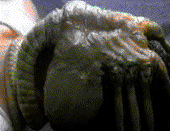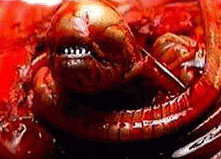T h e L i f e c y c l e
The lifecycle of an alien has several fases: egg, hugger, burster and the adult alien. And there are several kinds of adult aliens: those who live in hives (workers, perhaps), those who live in solitude (warriors, maybe) and queens.

The Egg
is a leathery object. Sometimes the sides of the egg is transparent and you can see what's inside. The egg is laid by a queen, but originally all adult female aliens could lay eggs. The egg must have some sort of sensory system, because when a possible host is near, it opens up and reveals it's content - a hugger. The hugger develops until it has reached its final form inside the egg. It lays in a kind of half slimy, half watery substance. This is surely some nutriment that the hugger lives on until a host comes by. The eggs can lay for many years without the huggers inside dying. The eggs and the huggers most likely goes into deathlike hibernation. But when a possible host comes in touch with the egg, it opens up like a flower. The opening of the egg has four "petals".

The Hugger
comes from the egg. Its purpose of life is simple: find host and lay egg in it. The eggs opens when a host is nearby. But how the hugger comes into the world depends on the conditions. If the soon to come host has been paralyzed, the hugger crawls out of the egg, having no hurry. But if the potential host is still on its feet, it launches itself from the egg at the very soon to come host with an amazing strength and speed. It attaches itself to the face of the host, grabs a hold of the hosts head with its digits and wraps its tail around the hosts neck. It then pushes a long tube down the unfortunate hosts throat. The tube has two purposes: to feed the host with oxygen, so he doesn't die of suffication and to lay the huggers' one egg. The host goes into a coma while the impregnation happens. The amount of time that the hugger is attached to the hosts face varies from just under one hour to about one whole day. This might vary with the type of alien. After it has laid its egg and the embryo is evolving as normal, the hugger detaches itself from the host, wanders off and dies. It has now fulfilled its purpose. Some huggers, though, seems to have the ability to lay two eggs, as shown in 'Alien 3'.
*The facehugger can change sex if there is no queen (hugger) nearby. The Queen carries the Q hugger with her with her smallest pair of arms. When the Queen dies, the Q facehugger leaps off and hibernates until a host walks by. The Q hugger will produce a Queen. You can recognize a Q hugger by it's higher ridges and spikes at the base of the tail. This information was mailed to me. Originally taken from the Aliens resource manual

The Burster
In the time between impregnation and the time when the burster appears, the embyro xenomorph lays in the chest area of the host, feeding apperantley from the neutritiant in the hosts blood. It doesn't do much except for growing. When the hugger has left the host, he or she wakes up, remembering nothing of what they have just been through. If the alien develops fast, the host seems to have few, if any, symtoms of the infection. But as in 'Alien 3', when it takes days before the embyro is finished developing, the host has headache, pain in the chest and feeling miserable. The burster itself differs. As seen in 'Alien' and on the picture, it could be nothing except a snakelike body and a mouth. In 'Alien 3', the burster is much more developed, having all the functions as an adult alien. But there were differences between these two 'types'. For the first: the hosts were of different species. In 'Alien', the host were humans, and in 'Alien 3', the host were a dog. The 'Alien' kind of xenomorph walked on two, just like humans, while the 'Alien 3' xenomorph walked on four, just like a dog. The '3' type also seemed to lack the spikes on the back, and was black of color, while the 'Alien' xenomorph was greyish. Ripley also states in '3': I've never seen anything like it! But if the differences was because that the host were of different species or that the different kinds would have different roles in a hive, is unknown. More on this later. The burster bursts its way out of the hosts chest in a violent act. The burster seems to be more vulnerable than the adult alien. The skin is bright and seems soft, and the little burster could more or less easily been killed by other individs. So that it runs for cover in 'Alien' would be just natural.
History Grey (Alien) Hive (Aliens) Queen Panther Newborn Rez Alien
Xenomorph Index Mail